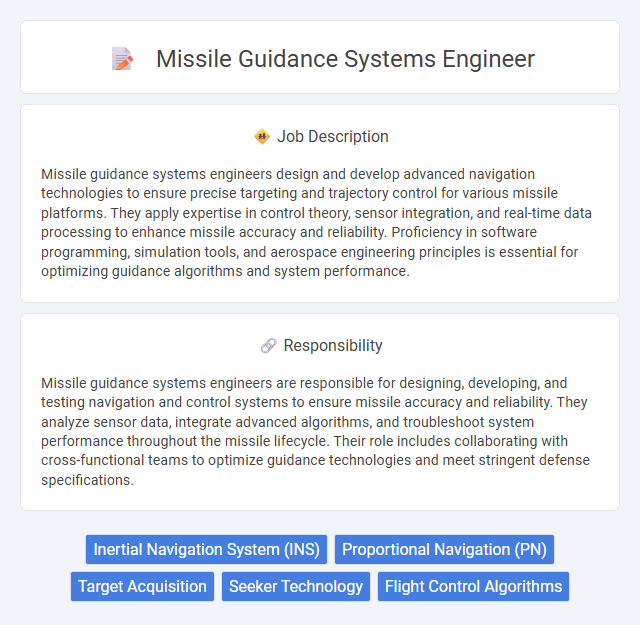
Missile guidance systems engineers design and develop advanced navigation technologies to ensure precise targeting and trajectory control for various missile platforms. They apply expertise in control theory, sensor integration, and real-time data processing to enhance missile accuracy and reliability. Proficiency in software programming, simulation tools, and aerospace engineering principles is essential for optimizing guidance algorithms and system performance.
Individuals with strong analytical skills and high stress tolerance are likely to thrive as missile guidance systems engineers due to the job's complex problem-solving demands and need for precision under pressure. Those comfortable with rigorous technical environments and continuous learning may find the role highly suitable, while candidates lacking interest in advanced mathematics or electronics might struggle to meet the job's requirements. The probability of success increases significantly for individuals who are detail-oriented, disciplined, and capable of working in collaborative multidisciplinary teams.
Qualification
Missile guidance systems engineers typically require a bachelor's degree in aerospace engineering, electrical engineering, or a related field, with many employers preferring a master's degree for advanced positions. Strong proficiency in control systems, signal processing, and embedded software development is essential, alongside experience with simulation tools such as MATLAB and Simulink. Certifications in systems engineering or project management can enhance qualifications, while security clearances are often necessary due to the sensitive nature of defense projects.
Responsibility
Missile guidance systems engineers are responsible for designing, developing, and testing navigation and control systems to ensure missile accuracy and reliability. They analyze sensor data, integrate advanced algorithms, and troubleshoot system performance throughout the missile lifecycle. Their role includes collaborating with cross-functional teams to optimize guidance technologies and meet stringent defense specifications.
Benefit
A career as a missile guidance systems engineer likely offers competitive salaries and opportunities for working on advanced defense technology, enhancing job security due to high demand in the defense sector. Professionals in this field often gain specialized skills in electronics, software development, and control systems, which may lead to career growth and cross-industry mobility. The role might also provide the satisfaction of contributing to national security and participating in cutting-edge research and development projects.
Challenge
Missile guidance systems engineering likely involves complex problem-solving challenges related to developing precise navigation algorithms and ensuring system reliability under dynamic conditions. Engineers probably face high-pressure scenarios to integrate advanced sensors and control mechanisms that maintain accuracy in unpredictable environments. The role may demand continuous adaptation to emerging technologies and rigorous testing to meet stringent defense standards.
Career Advancement
Missile guidance systems engineers advance their careers by mastering advanced control algorithms, signal processing techniques, and real-time embedded systems critical for missile accuracy. Gaining expertise in simulation tools, system integration, and hardware-in-the-loop testing enhances their ability to lead complex defense projects. Pursuing certifications in aerospace engineering, attending specialized training, and contributing to innovative defense technology research positions engineers for leadership roles and senior technical positions in the aerospace and defense industries.
Key Terms
Inertial Navigation System (INS)
Missile guidance systems engineers specializing in Inertial Navigation Systems (INS) design and develop precise navigation algorithms that rely on accelerometers and gyroscopes to calculate position, velocity, and orientation without external references. They optimize sensor fusion techniques to enhance accuracy and robustness against environmental disturbances, ensuring reliable missile trajectory control in GPS-denied environments. Proficiency in embedded systems programming, real-time signal processing, and error correction modeling is critical for successful INS implementation in advanced missile guidance solutions.
Proportional Navigation (PN)
Missile guidance systems engineers specializing in Proportional Navigation (PN) apply advanced algorithms to calculate real-time intercept trajectories, enhancing target tracking accuracy and missile efficiency. They develop and optimize PN control laws to minimize target miss distance by continuously adjusting the missile's flight path based on line-of-sight rate measurements. Mastery of sensor fusion, Kalman filtering, and dynamic system modeling is critical for implementing effective PN guidance in various missile platforms.
Target Acquisition
Missile guidance systems engineers specializing in target acquisition develop advanced algorithms and sensor integration techniques to accurately detect and track moving or stationary targets in complex environments. They leverage radar, infrared, and electro-optical technologies to enhance real-time data processing and improve missile trajectory precision. Expertise in signal processing, sensor fusion, and machine learning is crucial to optimize target identification and minimize false alarms.
Seeker Technology
A Missile Guidance Systems Engineer specializing in Seeker Technology develops advanced sensor systems that detect, track, and target objects with high precision. Expertise in infrared, radar, and electro-optical seekers is crucial for designing robust guidance algorithms that improve missile accuracy and reliability. Integration of real-time data processing and signal filtering techniques ensures optimal seeker performance in complex environments.
Flight Control Algorithms
Flight control algorithms are crucial in missile guidance systems engineering, enabling precise trajectory adjustments and real-time responsiveness to dynamic conditions. Engineers develop advanced control laws utilizing adaptive filters, Kalman filtering, and inertial navigation inputs to optimize missile stability and accuracy. Expertise in MATLAB/Simulink simulation and embedded system programming ensures robust implementation of these algorithms for autonomous missile navigation and interception.
 kuljobs.com
kuljobs.com